Exploring Drones: A Research Proposal for Public Transportation Use
VerifiedAdded on 2023/03/31
|12
|2478
|113
Project
AI Summary
This research proposal investigates the potential of using drones as a mode of public transportation to reduce urban traffic congestion and air pollution. It identifies the problem of increasing traffic and its associated environmental impacts, proposing drones as a novel solution. The study employs a positivism research philosophy with a descriptive research design and deductive approach, utilizing both quantitative (surveying 50 representatives from transportation agencies) and qualitative data analysis techniques. The expected outcomes include insights into the advantages and challenges of drone implementation, with potential future research directions focusing on solar-powered and wirelessly powered drones, as well as the impact of travel paths on drone performance. The reflective statement highlights the author's increased understanding of new technologies and their role in developing innovative transportation solutions. Desklib provides access to similar research papers and study tools for students.
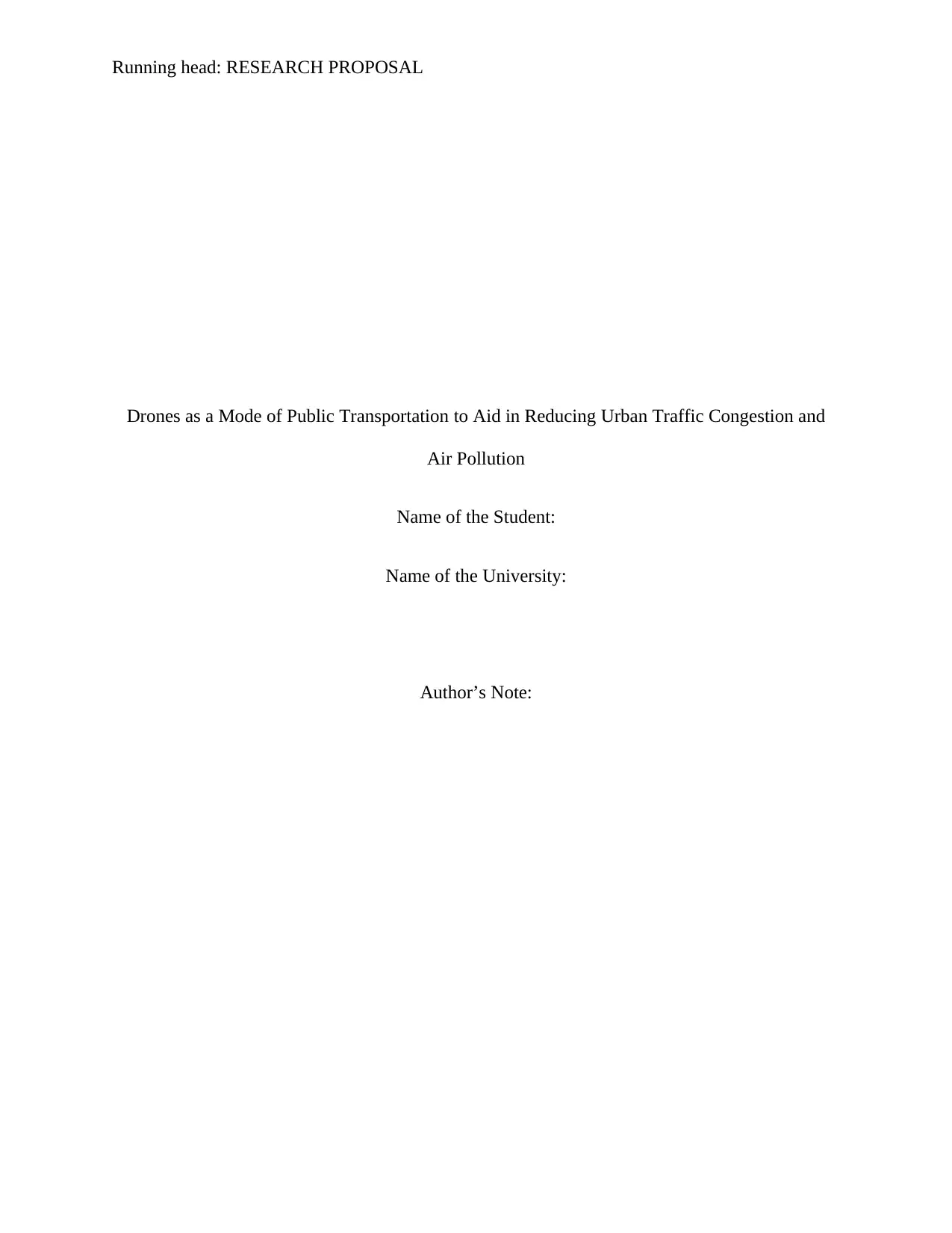
Running head: RESEARCH PROPOSAL
Drones as a Mode of Public Transportation to Aid in Reducing Urban Traffic Congestion and
Air Pollution
Name of the Student:
Name of the University:
Author’s Note:
Drones as a Mode of Public Transportation to Aid in Reducing Urban Traffic Congestion and
Air Pollution
Name of the Student:
Name of the University:
Author’s Note:
Paraphrase This Document
Need a fresh take? Get an instant paraphrase of this document with our AI Paraphraser
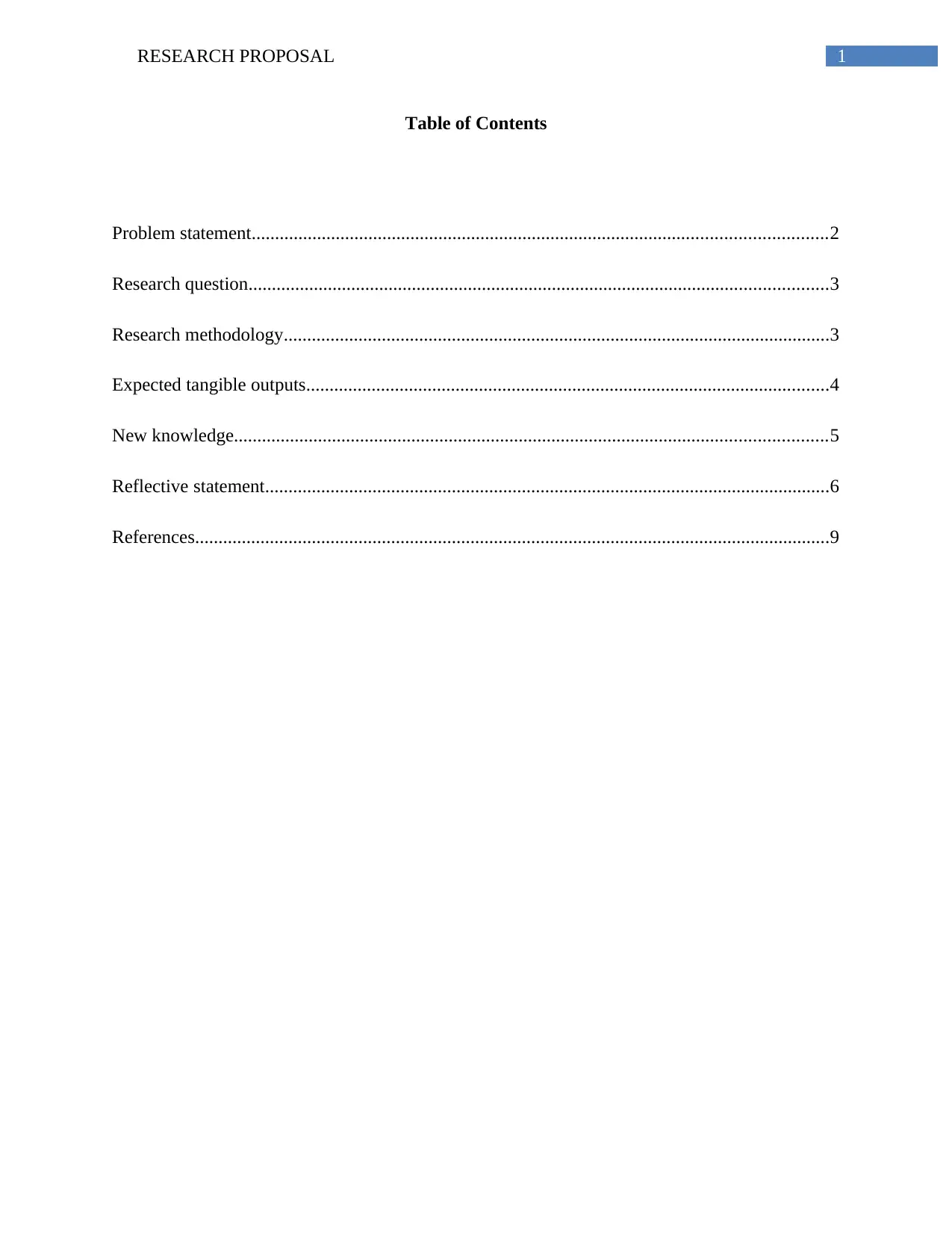
1RESEARCH PROPOSAL
Table of Contents
Problem statement...........................................................................................................................2
Research question............................................................................................................................3
Research methodology.....................................................................................................................3
Expected tangible outputs................................................................................................................4
New knowledge...............................................................................................................................5
Reflective statement.........................................................................................................................6
References........................................................................................................................................9
Table of Contents
Problem statement...........................................................................................................................2
Research question............................................................................................................................3
Research methodology.....................................................................................................................3
Expected tangible outputs................................................................................................................4
New knowledge...............................................................................................................................5
Reflective statement.........................................................................................................................6
References........................................................................................................................................9
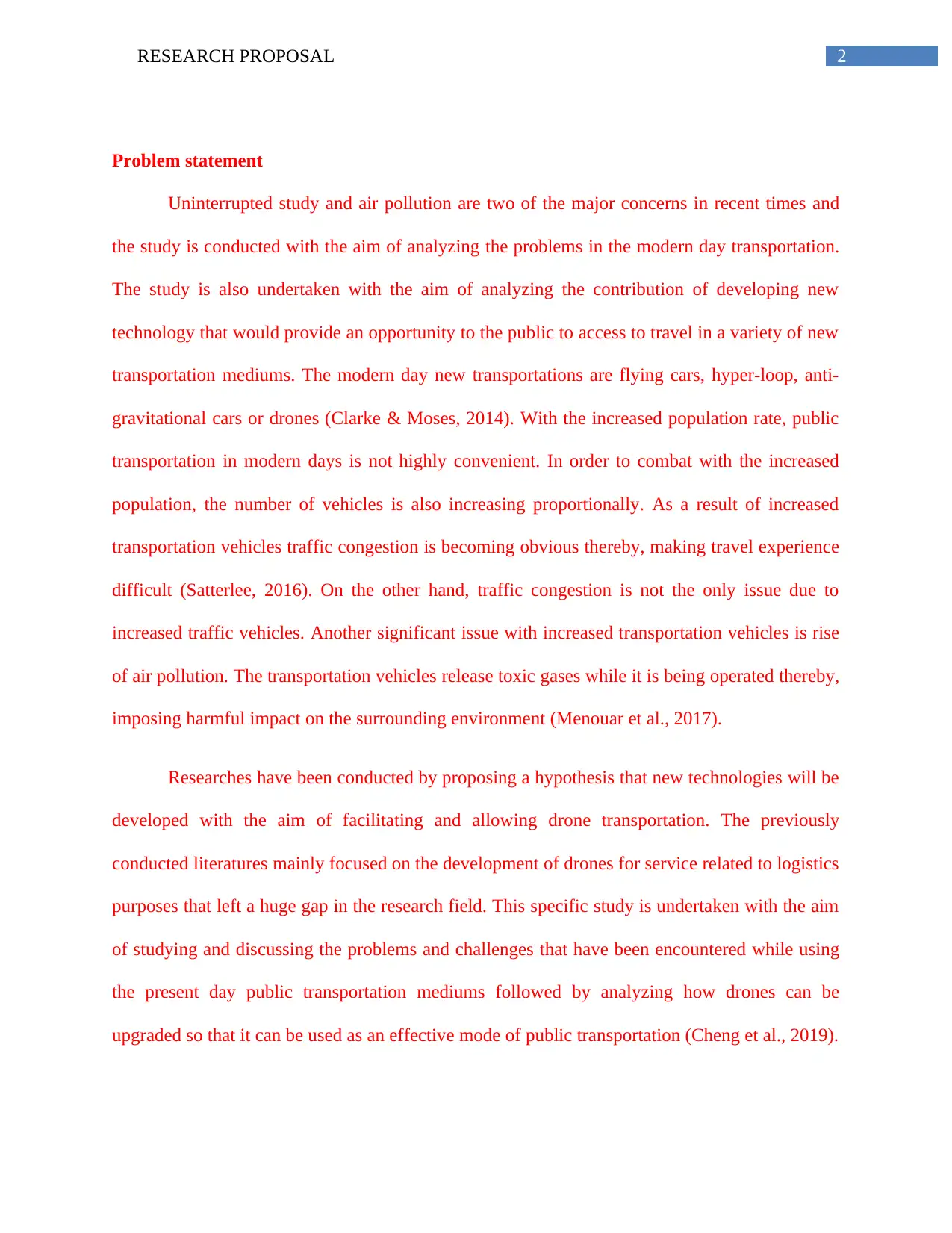
2RESEARCH PROPOSAL
Problem statement
Uninterrupted study and air pollution are two of the major concerns in recent times and
the study is conducted with the aim of analyzing the problems in the modern day transportation.
The study is also undertaken with the aim of analyzing the contribution of developing new
technology that would provide an opportunity to the public to access to travel in a variety of new
transportation mediums. The modern day new transportations are flying cars, hyper-loop, anti-
gravitational cars or drones (Clarke & Moses, 2014). With the increased population rate, public
transportation in modern days is not highly convenient. In order to combat with the increased
population, the number of vehicles is also increasing proportionally. As a result of increased
transportation vehicles traffic congestion is becoming obvious thereby, making travel experience
difficult (Satterlee, 2016). On the other hand, traffic congestion is not the only issue due to
increased traffic vehicles. Another significant issue with increased transportation vehicles is rise
of air pollution. The transportation vehicles release toxic gases while it is being operated thereby,
imposing harmful impact on the surrounding environment (Menouar et al., 2017).
Researches have been conducted by proposing a hypothesis that new technologies will be
developed with the aim of facilitating and allowing drone transportation. The previously
conducted literatures mainly focused on the development of drones for service related to logistics
purposes that left a huge gap in the research field. This specific study is undertaken with the aim
of studying and discussing the problems and challenges that have been encountered while using
the present day public transportation mediums followed by analyzing how drones can be
upgraded so that it can be used as an effective mode of public transportation (Cheng et al., 2019).
Problem statement
Uninterrupted study and air pollution are two of the major concerns in recent times and
the study is conducted with the aim of analyzing the problems in the modern day transportation.
The study is also undertaken with the aim of analyzing the contribution of developing new
technology that would provide an opportunity to the public to access to travel in a variety of new
transportation mediums. The modern day new transportations are flying cars, hyper-loop, anti-
gravitational cars or drones (Clarke & Moses, 2014). With the increased population rate, public
transportation in modern days is not highly convenient. In order to combat with the increased
population, the number of vehicles is also increasing proportionally. As a result of increased
transportation vehicles traffic congestion is becoming obvious thereby, making travel experience
difficult (Satterlee, 2016). On the other hand, traffic congestion is not the only issue due to
increased traffic vehicles. Another significant issue with increased transportation vehicles is rise
of air pollution. The transportation vehicles release toxic gases while it is being operated thereby,
imposing harmful impact on the surrounding environment (Menouar et al., 2017).
Researches have been conducted by proposing a hypothesis that new technologies will be
developed with the aim of facilitating and allowing drone transportation. The previously
conducted literatures mainly focused on the development of drones for service related to logistics
purposes that left a huge gap in the research field. This specific study is undertaken with the aim
of studying and discussing the problems and challenges that have been encountered while using
the present day public transportation mediums followed by analyzing how drones can be
upgraded so that it can be used as an effective mode of public transportation (Cheng et al., 2019).
⊘ This is a preview!⊘
Do you want full access?
Subscribe today to unlock all pages.

Trusted by 1+ million students worldwide
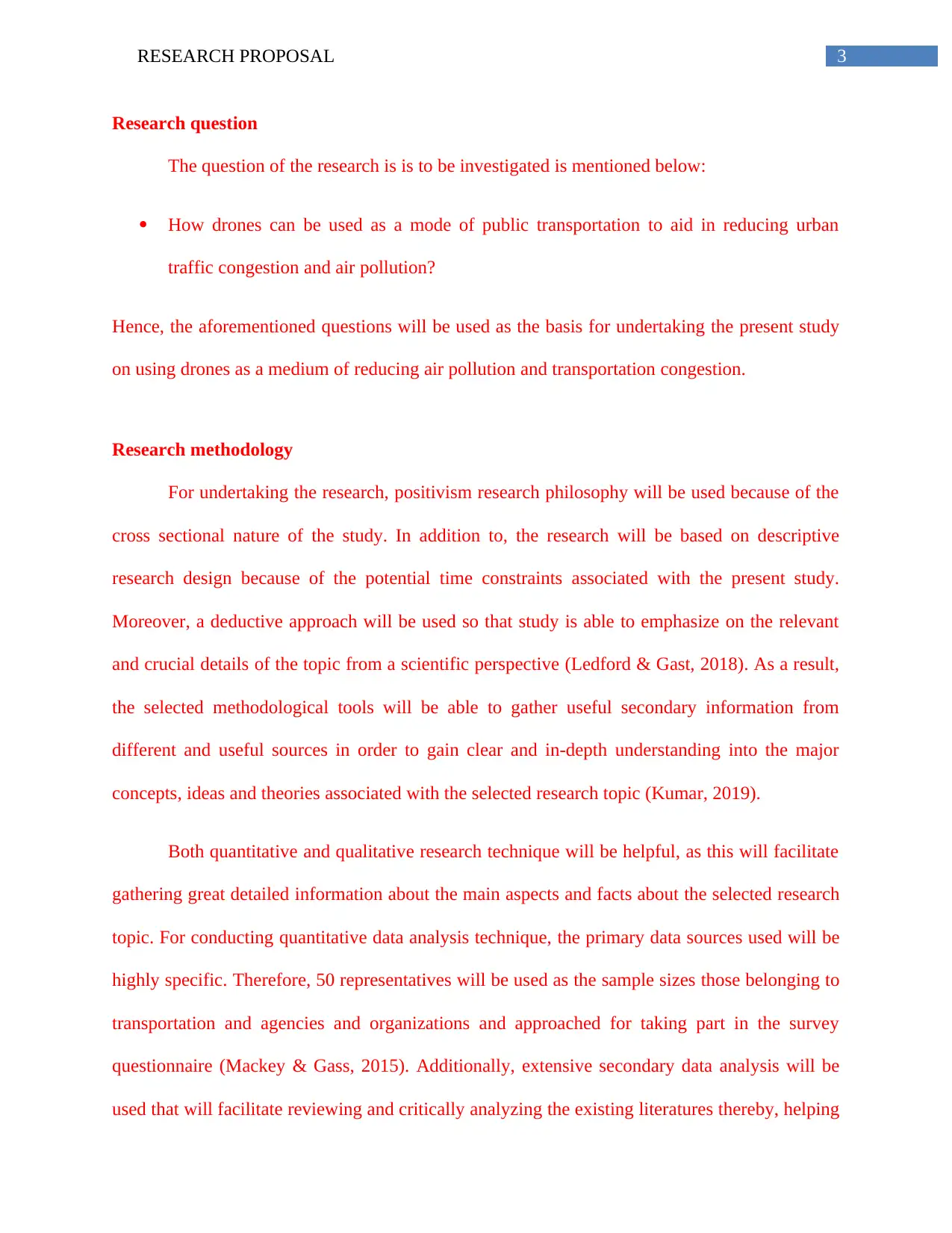
3RESEARCH PROPOSAL
Research question
The question of the research is is to be investigated is mentioned below:
How drones can be used as a mode of public transportation to aid in reducing urban
traffic congestion and air pollution?
Hence, the aforementioned questions will be used as the basis for undertaking the present study
on using drones as a medium of reducing air pollution and transportation congestion.
Research methodology
For undertaking the research, positivism research philosophy will be used because of the
cross sectional nature of the study. In addition to, the research will be based on descriptive
research design because of the potential time constraints associated with the present study.
Moreover, a deductive approach will be used so that study is able to emphasize on the relevant
and crucial details of the topic from a scientific perspective (Ledford & Gast, 2018). As a result,
the selected methodological tools will be able to gather useful secondary information from
different and useful sources in order to gain clear and in-depth understanding into the major
concepts, ideas and theories associated with the selected research topic (Kumar, 2019).
Both quantitative and qualitative research technique will be helpful, as this will facilitate
gathering great detailed information about the main aspects and facts about the selected research
topic. For conducting quantitative data analysis technique, the primary data sources used will be
highly specific. Therefore, 50 representatives will be used as the sample sizes those belonging to
transportation and agencies and organizations and approached for taking part in the survey
questionnaire (Mackey & Gass, 2015). Additionally, extensive secondary data analysis will be
used that will facilitate reviewing and critically analyzing the existing literatures thereby, helping
Research question
The question of the research is is to be investigated is mentioned below:
How drones can be used as a mode of public transportation to aid in reducing urban
traffic congestion and air pollution?
Hence, the aforementioned questions will be used as the basis for undertaking the present study
on using drones as a medium of reducing air pollution and transportation congestion.
Research methodology
For undertaking the research, positivism research philosophy will be used because of the
cross sectional nature of the study. In addition to, the research will be based on descriptive
research design because of the potential time constraints associated with the present study.
Moreover, a deductive approach will be used so that study is able to emphasize on the relevant
and crucial details of the topic from a scientific perspective (Ledford & Gast, 2018). As a result,
the selected methodological tools will be able to gather useful secondary information from
different and useful sources in order to gain clear and in-depth understanding into the major
concepts, ideas and theories associated with the selected research topic (Kumar, 2019).
Both quantitative and qualitative research technique will be helpful, as this will facilitate
gathering great detailed information about the main aspects and facts about the selected research
topic. For conducting quantitative data analysis technique, the primary data sources used will be
highly specific. Therefore, 50 representatives will be used as the sample sizes those belonging to
transportation and agencies and organizations and approached for taking part in the survey
questionnaire (Mackey & Gass, 2015). Additionally, extensive secondary data analysis will be
used that will facilitate reviewing and critically analyzing the existing literatures thereby, helping
Paraphrase This Document
Need a fresh take? Get an instant paraphrase of this document with our AI Paraphraser
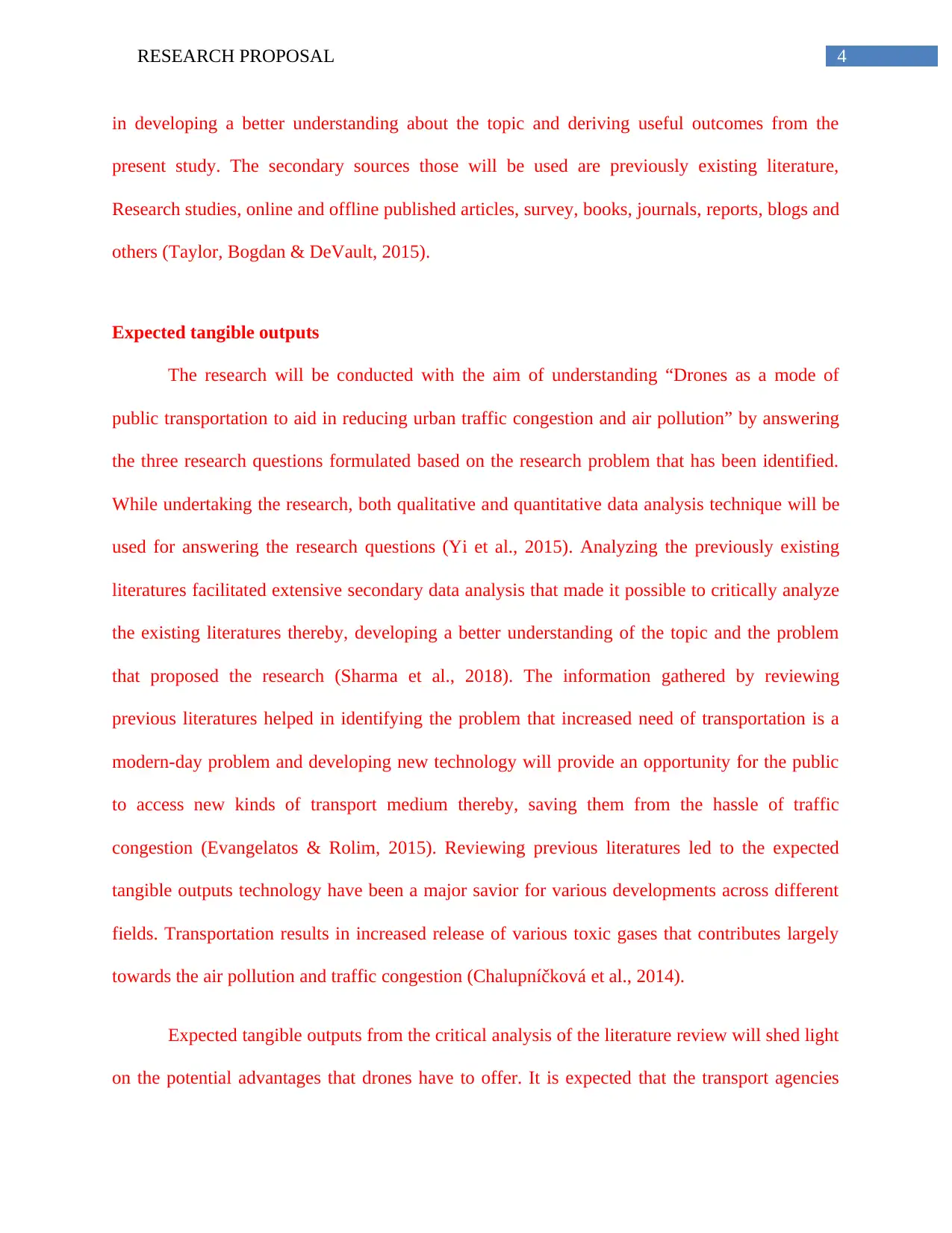
4RESEARCH PROPOSAL
in developing a better understanding about the topic and deriving useful outcomes from the
present study. The secondary sources those will be used are previously existing literature,
Research studies, online and offline published articles, survey, books, journals, reports, blogs and
others (Taylor, Bogdan & DeVault, 2015).
Expected tangible outputs
The research will be conducted with the aim of understanding “Drones as a mode of
public transportation to aid in reducing urban traffic congestion and air pollution” by answering
the three research questions formulated based on the research problem that has been identified.
While undertaking the research, both qualitative and quantitative data analysis technique will be
used for answering the research questions (Yi et al., 2015). Analyzing the previously existing
literatures facilitated extensive secondary data analysis that made it possible to critically analyze
the existing literatures thereby, developing a better understanding of the topic and the problem
that proposed the research (Sharma et al., 2018). The information gathered by reviewing
previous literatures helped in identifying the problem that increased need of transportation is a
modern-day problem and developing new technology will provide an opportunity for the public
to access new kinds of transport medium thereby, saving them from the hassle of traffic
congestion (Evangelatos & Rolim, 2015). Reviewing previous literatures led to the expected
tangible outputs technology have been a major savior for various developments across different
fields. Transportation results in increased release of various toxic gases that contributes largely
towards the air pollution and traffic congestion (Chalupníčková et al., 2014).
Expected tangible outputs from the critical analysis of the literature review will shed light
on the potential advantages that drones have to offer. It is expected that the transport agencies
in developing a better understanding about the topic and deriving useful outcomes from the
present study. The secondary sources those will be used are previously existing literature,
Research studies, online and offline published articles, survey, books, journals, reports, blogs and
others (Taylor, Bogdan & DeVault, 2015).
Expected tangible outputs
The research will be conducted with the aim of understanding “Drones as a mode of
public transportation to aid in reducing urban traffic congestion and air pollution” by answering
the three research questions formulated based on the research problem that has been identified.
While undertaking the research, both qualitative and quantitative data analysis technique will be
used for answering the research questions (Yi et al., 2015). Analyzing the previously existing
literatures facilitated extensive secondary data analysis that made it possible to critically analyze
the existing literatures thereby, developing a better understanding of the topic and the problem
that proposed the research (Sharma et al., 2018). The information gathered by reviewing
previous literatures helped in identifying the problem that increased need of transportation is a
modern-day problem and developing new technology will provide an opportunity for the public
to access new kinds of transport medium thereby, saving them from the hassle of traffic
congestion (Evangelatos & Rolim, 2015). Reviewing previous literatures led to the expected
tangible outputs technology have been a major savior for various developments across different
fields. Transportation results in increased release of various toxic gases that contributes largely
towards the air pollution and traffic congestion (Chalupníčková et al., 2014).
Expected tangible outputs from the critical analysis of the literature review will shed light
on the potential advantages that drones have to offer. It is expected that the transport agencies
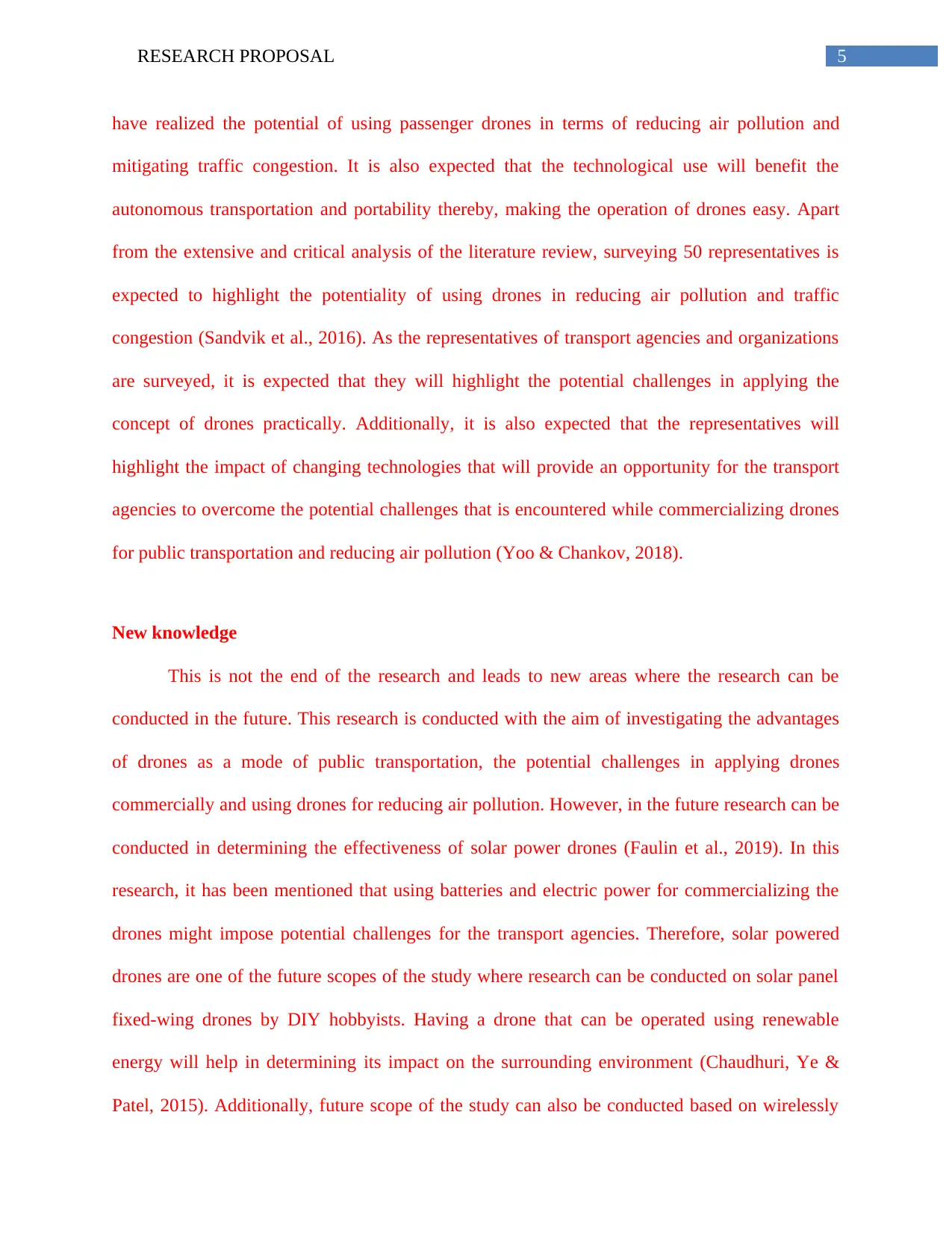
5RESEARCH PROPOSAL
have realized the potential of using passenger drones in terms of reducing air pollution and
mitigating traffic congestion. It is also expected that the technological use will benefit the
autonomous transportation and portability thereby, making the operation of drones easy. Apart
from the extensive and critical analysis of the literature review, surveying 50 representatives is
expected to highlight the potentiality of using drones in reducing air pollution and traffic
congestion (Sandvik et al., 2016). As the representatives of transport agencies and organizations
are surveyed, it is expected that they will highlight the potential challenges in applying the
concept of drones practically. Additionally, it is also expected that the representatives will
highlight the impact of changing technologies that will provide an opportunity for the transport
agencies to overcome the potential challenges that is encountered while commercializing drones
for public transportation and reducing air pollution (Yoo & Chankov, 2018).
New knowledge
This is not the end of the research and leads to new areas where the research can be
conducted in the future. This research is conducted with the aim of investigating the advantages
of drones as a mode of public transportation, the potential challenges in applying drones
commercially and using drones for reducing air pollution. However, in the future research can be
conducted in determining the effectiveness of solar power drones (Faulin et al., 2019). In this
research, it has been mentioned that using batteries and electric power for commercializing the
drones might impose potential challenges for the transport agencies. Therefore, solar powered
drones are one of the future scopes of the study where research can be conducted on solar panel
fixed-wing drones by DIY hobbyists. Having a drone that can be operated using renewable
energy will help in determining its impact on the surrounding environment (Chaudhuri, Ye &
Patel, 2015). Additionally, future scope of the study can also be conducted based on wirelessly
have realized the potential of using passenger drones in terms of reducing air pollution and
mitigating traffic congestion. It is also expected that the technological use will benefit the
autonomous transportation and portability thereby, making the operation of drones easy. Apart
from the extensive and critical analysis of the literature review, surveying 50 representatives is
expected to highlight the potentiality of using drones in reducing air pollution and traffic
congestion (Sandvik et al., 2016). As the representatives of transport agencies and organizations
are surveyed, it is expected that they will highlight the potential challenges in applying the
concept of drones practically. Additionally, it is also expected that the representatives will
highlight the impact of changing technologies that will provide an opportunity for the transport
agencies to overcome the potential challenges that is encountered while commercializing drones
for public transportation and reducing air pollution (Yoo & Chankov, 2018).
New knowledge
This is not the end of the research and leads to new areas where the research can be
conducted in the future. This research is conducted with the aim of investigating the advantages
of drones as a mode of public transportation, the potential challenges in applying drones
commercially and using drones for reducing air pollution. However, in the future research can be
conducted in determining the effectiveness of solar power drones (Faulin et al., 2019). In this
research, it has been mentioned that using batteries and electric power for commercializing the
drones might impose potential challenges for the transport agencies. Therefore, solar powered
drones are one of the future scopes of the study where research can be conducted on solar panel
fixed-wing drones by DIY hobbyists. Having a drone that can be operated using renewable
energy will help in determining its impact on the surrounding environment (Chaudhuri, Ye &
Patel, 2015). Additionally, future scope of the study can also be conducted based on wirelessly
⊘ This is a preview!⊘
Do you want full access?
Subscribe today to unlock all pages.

Trusted by 1+ million students worldwide
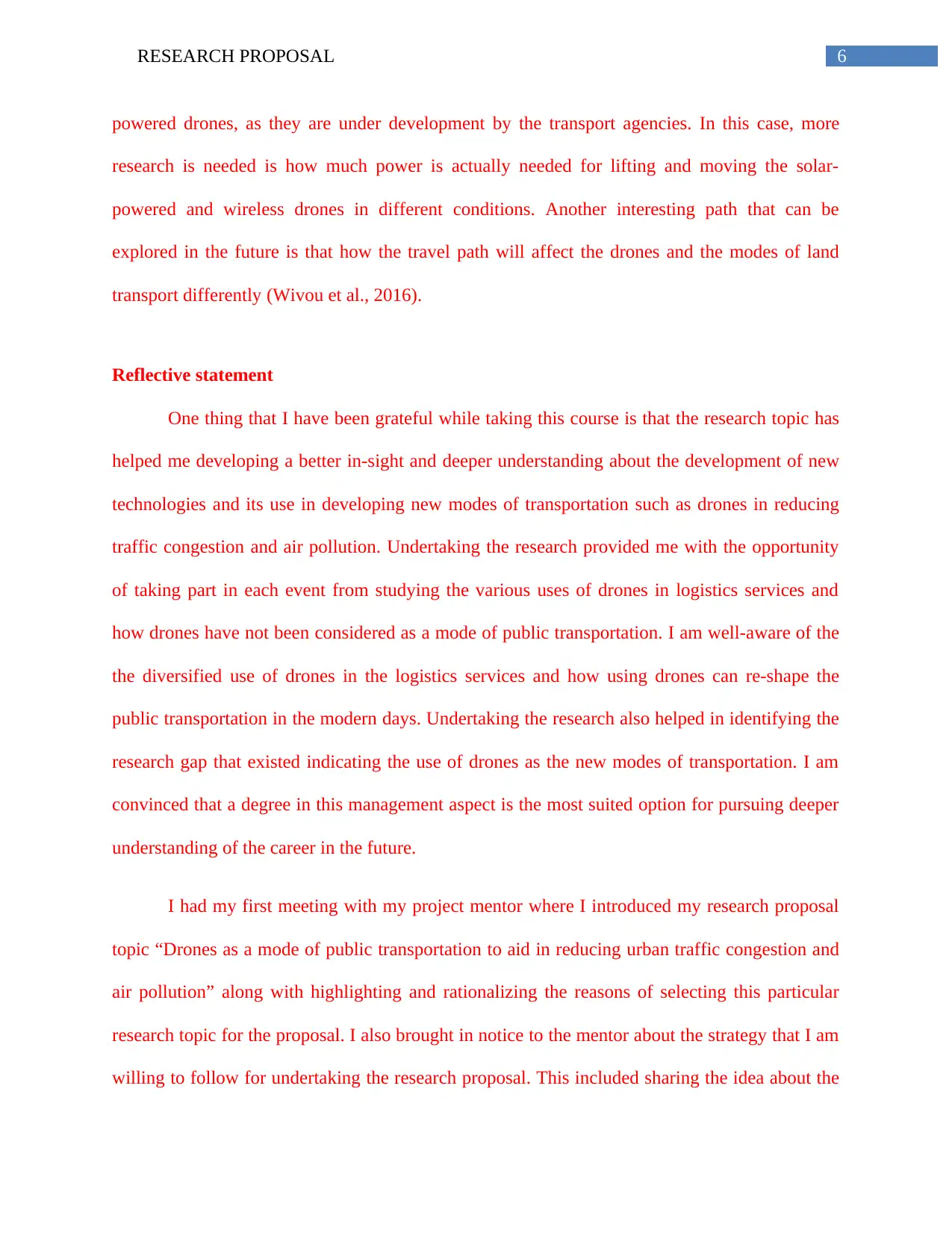
6RESEARCH PROPOSAL
powered drones, as they are under development by the transport agencies. In this case, more
research is needed is how much power is actually needed for lifting and moving the solar-
powered and wireless drones in different conditions. Another interesting path that can be
explored in the future is that how the travel path will affect the drones and the modes of land
transport differently (Wivou et al., 2016).
Reflective statement
One thing that I have been grateful while taking this course is that the research topic has
helped me developing a better in-sight and deeper understanding about the development of new
technologies and its use in developing new modes of transportation such as drones in reducing
traffic congestion and air pollution. Undertaking the research provided me with the opportunity
of taking part in each event from studying the various uses of drones in logistics services and
how drones have not been considered as a mode of public transportation. I am well-aware of the
the diversified use of drones in the logistics services and how using drones can re-shape the
public transportation in the modern days. Undertaking the research also helped in identifying the
research gap that existed indicating the use of drones as the new modes of transportation. I am
convinced that a degree in this management aspect is the most suited option for pursuing deeper
understanding of the career in the future.
I had my first meeting with my project mentor where I introduced my research proposal
topic “Drones as a mode of public transportation to aid in reducing urban traffic congestion and
air pollution” along with highlighting and rationalizing the reasons of selecting this particular
research topic for the proposal. I also brought in notice to the mentor about the strategy that I am
willing to follow for undertaking the research proposal. This included sharing the idea about the
powered drones, as they are under development by the transport agencies. In this case, more
research is needed is how much power is actually needed for lifting and moving the solar-
powered and wireless drones in different conditions. Another interesting path that can be
explored in the future is that how the travel path will affect the drones and the modes of land
transport differently (Wivou et al., 2016).
Reflective statement
One thing that I have been grateful while taking this course is that the research topic has
helped me developing a better in-sight and deeper understanding about the development of new
technologies and its use in developing new modes of transportation such as drones in reducing
traffic congestion and air pollution. Undertaking the research provided me with the opportunity
of taking part in each event from studying the various uses of drones in logistics services and
how drones have not been considered as a mode of public transportation. I am well-aware of the
the diversified use of drones in the logistics services and how using drones can re-shape the
public transportation in the modern days. Undertaking the research also helped in identifying the
research gap that existed indicating the use of drones as the new modes of transportation. I am
convinced that a degree in this management aspect is the most suited option for pursuing deeper
understanding of the career in the future.
I had my first meeting with my project mentor where I introduced my research proposal
topic “Drones as a mode of public transportation to aid in reducing urban traffic congestion and
air pollution” along with highlighting and rationalizing the reasons of selecting this particular
research topic for the proposal. I also brought in notice to the mentor about the strategy that I am
willing to follow for undertaking the research proposal. This included sharing the idea about the
Paraphrase This Document
Need a fresh take? Get an instant paraphrase of this document with our AI Paraphraser
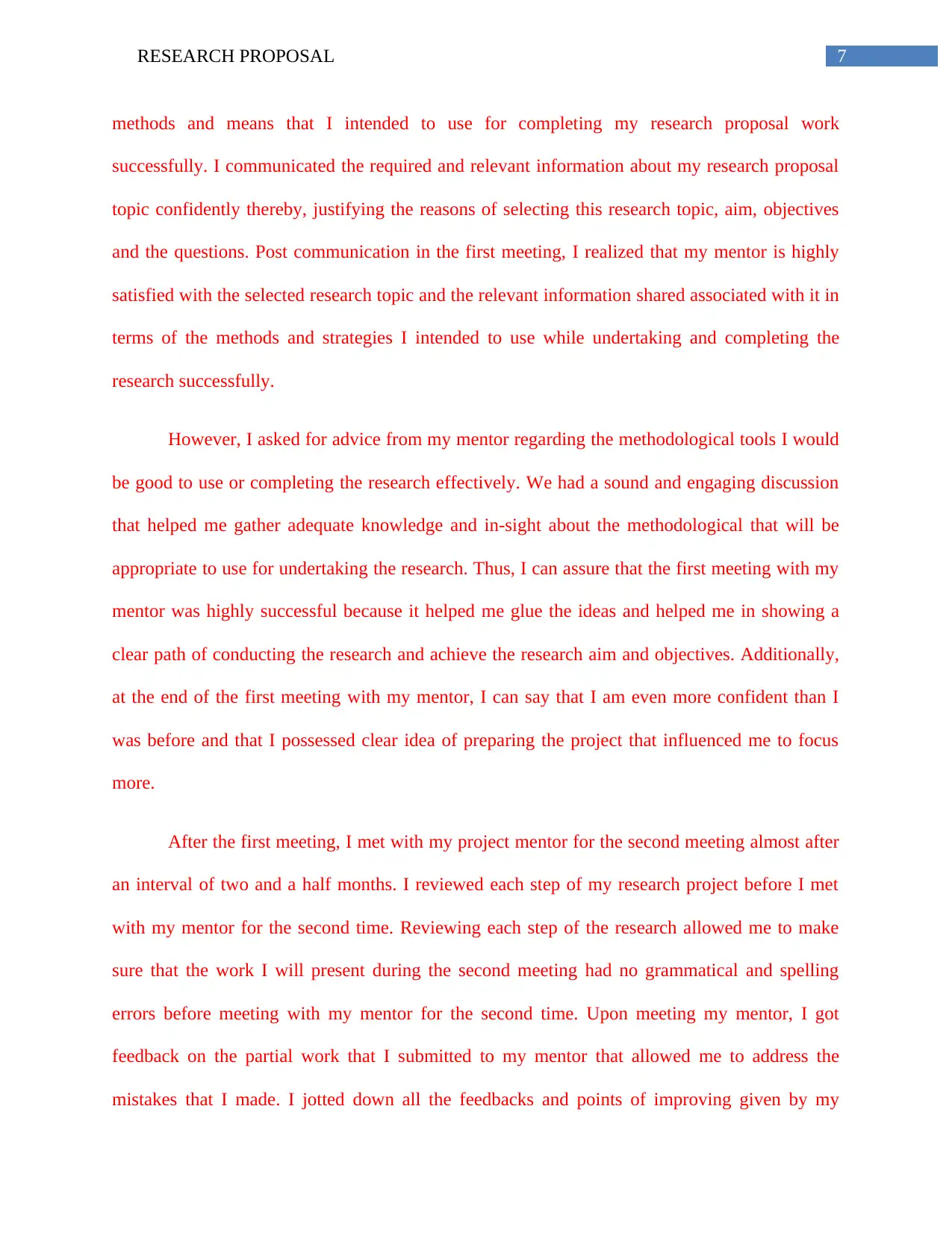
7RESEARCH PROPOSAL
methods and means that I intended to use for completing my research proposal work
successfully. I communicated the required and relevant information about my research proposal
topic confidently thereby, justifying the reasons of selecting this research topic, aim, objectives
and the questions. Post communication in the first meeting, I realized that my mentor is highly
satisfied with the selected research topic and the relevant information shared associated with it in
terms of the methods and strategies I intended to use while undertaking and completing the
research successfully.
However, I asked for advice from my mentor regarding the methodological tools I would
be good to use or completing the research effectively. We had a sound and engaging discussion
that helped me gather adequate knowledge and in-sight about the methodological that will be
appropriate to use for undertaking the research. Thus, I can assure that the first meeting with my
mentor was highly successful because it helped me glue the ideas and helped me in showing a
clear path of conducting the research and achieve the research aim and objectives. Additionally,
at the end of the first meeting with my mentor, I can say that I am even more confident than I
was before and that I possessed clear idea of preparing the project that influenced me to focus
more.
After the first meeting, I met with my project mentor for the second meeting almost after
an interval of two and a half months. I reviewed each step of my research project before I met
with my mentor for the second time. Reviewing each step of the research allowed me to make
sure that the work I will present during the second meeting had no grammatical and spelling
errors before meeting with my mentor for the second time. Upon meeting my mentor, I got
feedback on the partial work that I submitted to my mentor that allowed me to address the
mistakes that I made. I jotted down all the feedbacks and points of improving given by my
methods and means that I intended to use for completing my research proposal work
successfully. I communicated the required and relevant information about my research proposal
topic confidently thereby, justifying the reasons of selecting this research topic, aim, objectives
and the questions. Post communication in the first meeting, I realized that my mentor is highly
satisfied with the selected research topic and the relevant information shared associated with it in
terms of the methods and strategies I intended to use while undertaking and completing the
research successfully.
However, I asked for advice from my mentor regarding the methodological tools I would
be good to use or completing the research effectively. We had a sound and engaging discussion
that helped me gather adequate knowledge and in-sight about the methodological that will be
appropriate to use for undertaking the research. Thus, I can assure that the first meeting with my
mentor was highly successful because it helped me glue the ideas and helped me in showing a
clear path of conducting the research and achieve the research aim and objectives. Additionally,
at the end of the first meeting with my mentor, I can say that I am even more confident than I
was before and that I possessed clear idea of preparing the project that influenced me to focus
more.
After the first meeting, I met with my project mentor for the second meeting almost after
an interval of two and a half months. I reviewed each step of my research project before I met
with my mentor for the second time. Reviewing each step of the research allowed me to make
sure that the work I will present during the second meeting had no grammatical and spelling
errors before meeting with my mentor for the second time. Upon meeting my mentor, I got
feedback on the partial work that I submitted to my mentor that allowed me to address the
mistakes that I made. I jotted down all the feedbacks and points of improving given by my
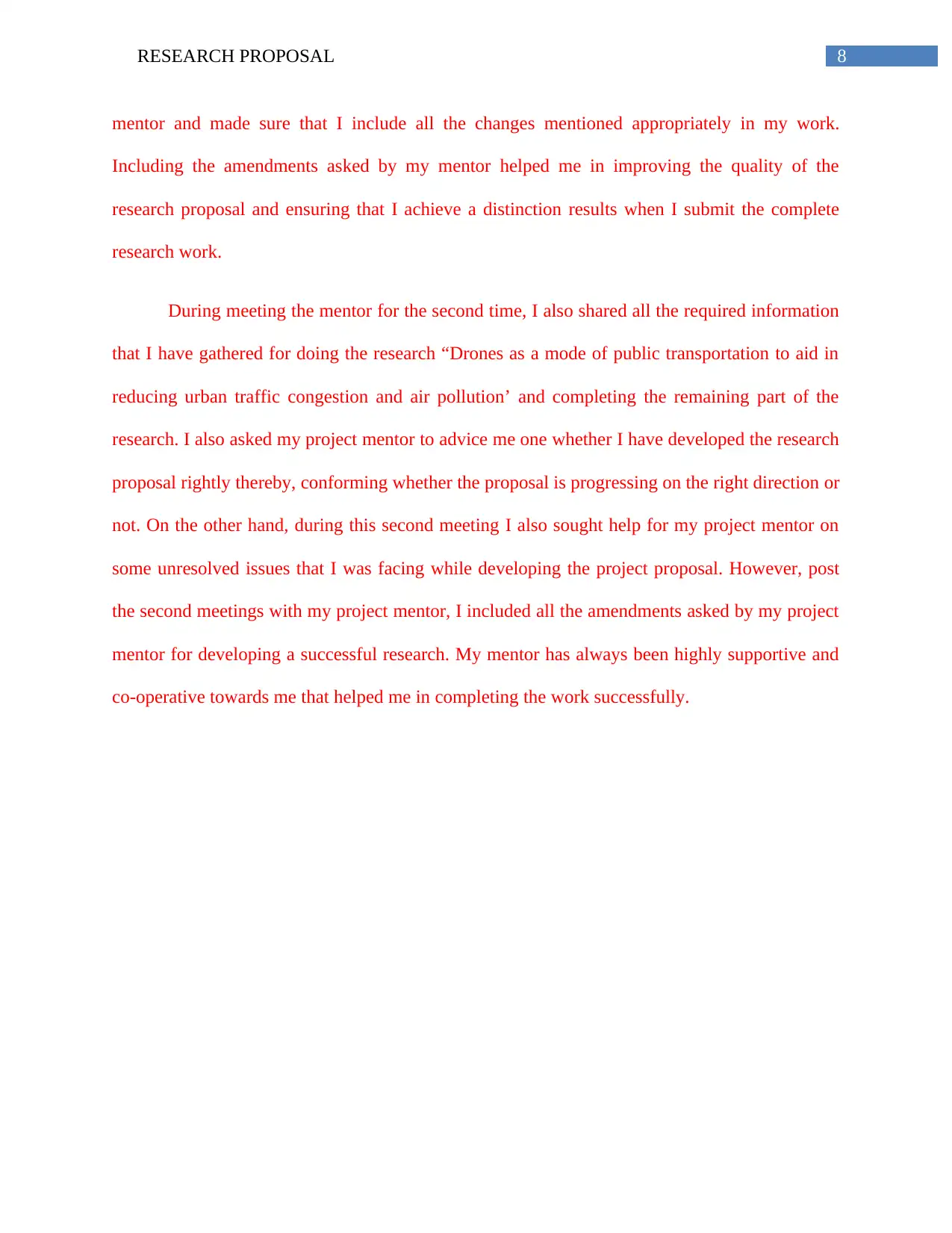
8RESEARCH PROPOSAL
mentor and made sure that I include all the changes mentioned appropriately in my work.
Including the amendments asked by my mentor helped me in improving the quality of the
research proposal and ensuring that I achieve a distinction results when I submit the complete
research work.
During meeting the mentor for the second time, I also shared all the required information
that I have gathered for doing the research “Drones as a mode of public transportation to aid in
reducing urban traffic congestion and air pollution’ and completing the remaining part of the
research. I also asked my project mentor to advice me one whether I have developed the research
proposal rightly thereby, conforming whether the proposal is progressing on the right direction or
not. On the other hand, during this second meeting I also sought help for my project mentor on
some unresolved issues that I was facing while developing the project proposal. However, post
the second meetings with my project mentor, I included all the amendments asked by my project
mentor for developing a successful research. My mentor has always been highly supportive and
co-operative towards me that helped me in completing the work successfully.
mentor and made sure that I include all the changes mentioned appropriately in my work.
Including the amendments asked by my mentor helped me in improving the quality of the
research proposal and ensuring that I achieve a distinction results when I submit the complete
research work.
During meeting the mentor for the second time, I also shared all the required information
that I have gathered for doing the research “Drones as a mode of public transportation to aid in
reducing urban traffic congestion and air pollution’ and completing the remaining part of the
research. I also asked my project mentor to advice me one whether I have developed the research
proposal rightly thereby, conforming whether the proposal is progressing on the right direction or
not. On the other hand, during this second meeting I also sought help for my project mentor on
some unresolved issues that I was facing while developing the project proposal. However, post
the second meetings with my project mentor, I included all the amendments asked by my project
mentor for developing a successful research. My mentor has always been highly supportive and
co-operative towards me that helped me in completing the work successfully.
⊘ This is a preview!⊘
Do you want full access?
Subscribe today to unlock all pages.

Trusted by 1+ million students worldwide
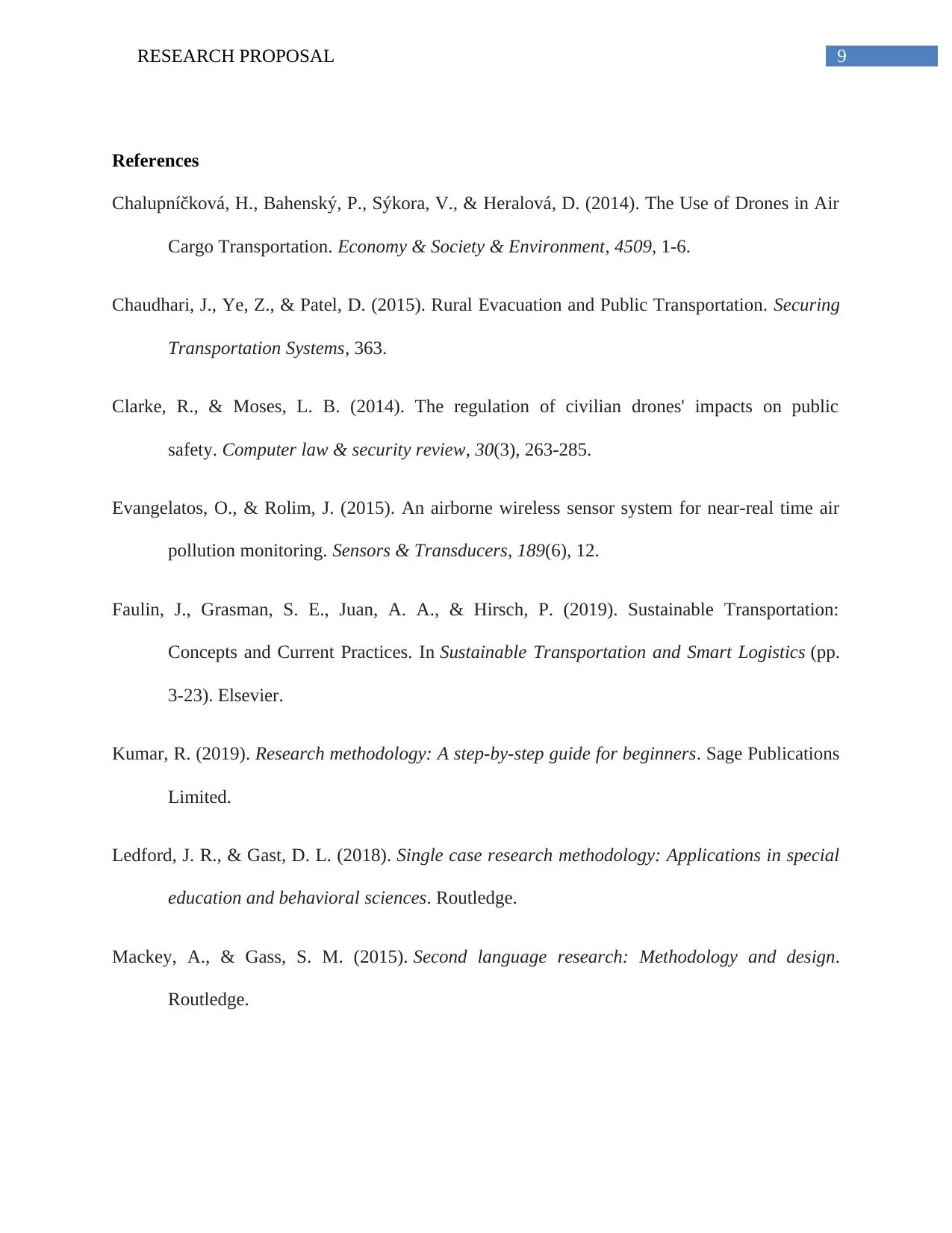
9RESEARCH PROPOSAL
References
Chalupníčková, H., Bahenský, P., Sýkora, V., & Heralová, D. (2014). The Use of Drones in Air
Cargo Transportation. Economy & Society & Environment, 4509, 1-6.
Chaudhari, J., Ye, Z., & Patel, D. (2015). Rural Evacuation and Public Transportation. Securing
Transportation Systems, 363.
Clarke, R., & Moses, L. B. (2014). The regulation of civilian drones' impacts on public
safety. Computer law & security review, 30(3), 263-285.
Evangelatos, O., & Rolim, J. (2015). An airborne wireless sensor system for near-real time air
pollution monitoring. Sensors & Transducers, 189(6), 12.
Faulin, J., Grasman, S. E., Juan, A. A., & Hirsch, P. (2019). Sustainable Transportation:
Concepts and Current Practices. In Sustainable Transportation and Smart Logistics (pp.
3-23). Elsevier.
Kumar, R. (2019). Research methodology: A step-by-step guide for beginners. Sage Publications
Limited.
Ledford, J. R., & Gast, D. L. (2018). Single case research methodology: Applications in special
education and behavioral sciences. Routledge.
Mackey, A., & Gass, S. M. (2015). Second language research: Methodology and design.
Routledge.
References
Chalupníčková, H., Bahenský, P., Sýkora, V., & Heralová, D. (2014). The Use of Drones in Air
Cargo Transportation. Economy & Society & Environment, 4509, 1-6.
Chaudhari, J., Ye, Z., & Patel, D. (2015). Rural Evacuation and Public Transportation. Securing
Transportation Systems, 363.
Clarke, R., & Moses, L. B. (2014). The regulation of civilian drones' impacts on public
safety. Computer law & security review, 30(3), 263-285.
Evangelatos, O., & Rolim, J. (2015). An airborne wireless sensor system for near-real time air
pollution monitoring. Sensors & Transducers, 189(6), 12.
Faulin, J., Grasman, S. E., Juan, A. A., & Hirsch, P. (2019). Sustainable Transportation:
Concepts and Current Practices. In Sustainable Transportation and Smart Logistics (pp.
3-23). Elsevier.
Kumar, R. (2019). Research methodology: A step-by-step guide for beginners. Sage Publications
Limited.
Ledford, J. R., & Gast, D. L. (2018). Single case research methodology: Applications in special
education and behavioral sciences. Routledge.
Mackey, A., & Gass, S. M. (2015). Second language research: Methodology and design.
Routledge.
Paraphrase This Document
Need a fresh take? Get an instant paraphrase of this document with our AI Paraphraser
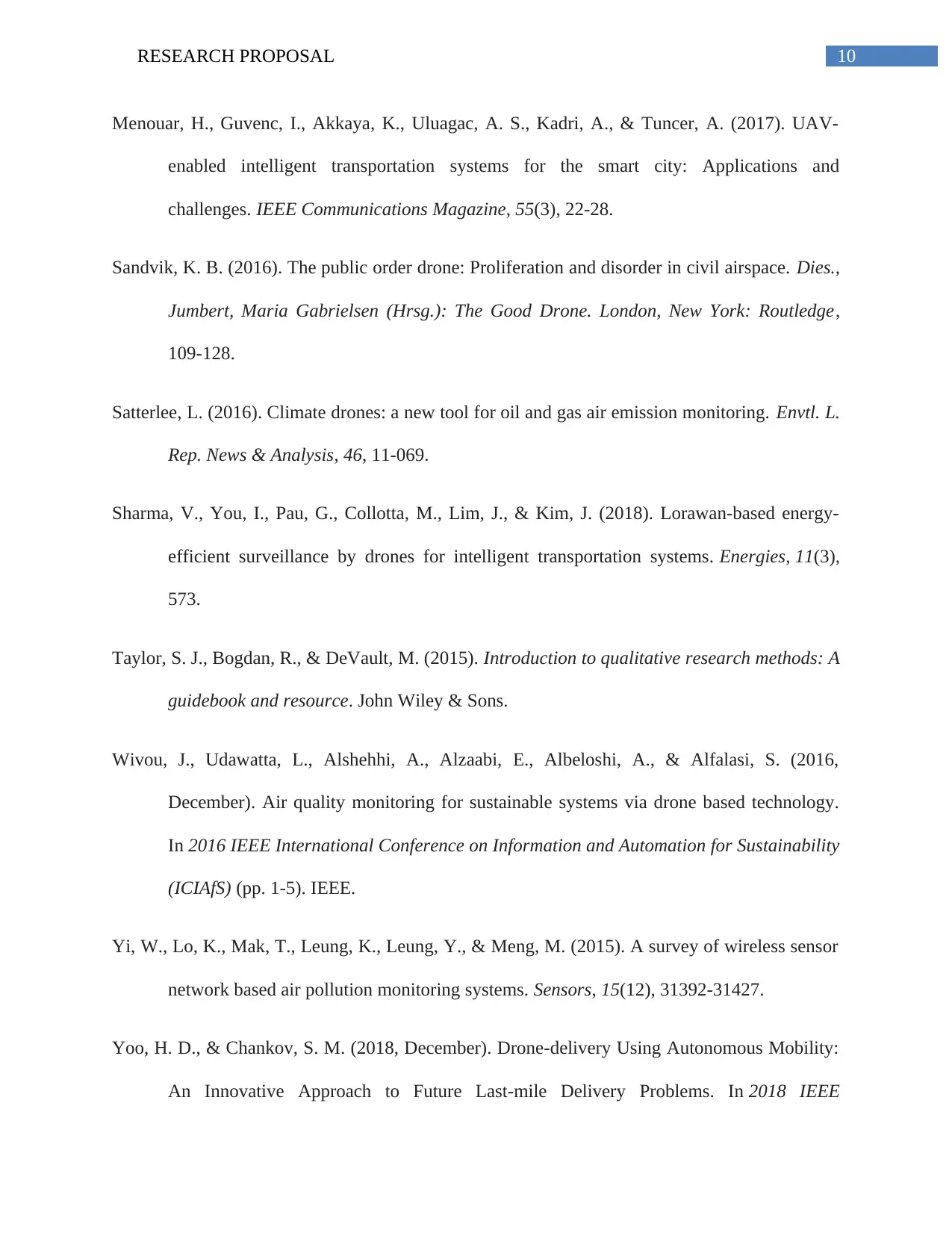
10RESEARCH PROPOSAL
Menouar, H., Guvenc, I., Akkaya, K., Uluagac, A. S., Kadri, A., & Tuncer, A. (2017). UAV-
enabled intelligent transportation systems for the smart city: Applications and
challenges. IEEE Communications Magazine, 55(3), 22-28.
Sandvik, K. B. (2016). The public order drone: Proliferation and disorder in civil airspace. Dies.,
Jumbert, Maria Gabrielsen (Hrsg.): The Good Drone. London, New York: Routledge,
109-128.
Satterlee, L. (2016). Climate drones: a new tool for oil and gas air emission monitoring. Envtl. L.
Rep. News & Analysis, 46, 11-069.
Sharma, V., You, I., Pau, G., Collotta, M., Lim, J., & Kim, J. (2018). Lorawan-based energy-
efficient surveillance by drones for intelligent transportation systems. Energies, 11(3),
573.
Taylor, S. J., Bogdan, R., & DeVault, M. (2015). Introduction to qualitative research methods: A
guidebook and resource. John Wiley & Sons.
Wivou, J., Udawatta, L., Alshehhi, A., Alzaabi, E., Albeloshi, A., & Alfalasi, S. (2016,
December). Air quality monitoring for sustainable systems via drone based technology.
In 2016 IEEE International Conference on Information and Automation for Sustainability
(ICIAfS) (pp. 1-5). IEEE.
Yi, W., Lo, K., Mak, T., Leung, K., Leung, Y., & Meng, M. (2015). A survey of wireless sensor
network based air pollution monitoring systems. Sensors, 15(12), 31392-31427.
Yoo, H. D., & Chankov, S. M. (2018, December). Drone-delivery Using Autonomous Mobility:
An Innovative Approach to Future Last-mile Delivery Problems. In 2018 IEEE
Menouar, H., Guvenc, I., Akkaya, K., Uluagac, A. S., Kadri, A., & Tuncer, A. (2017). UAV-
enabled intelligent transportation systems for the smart city: Applications and
challenges. IEEE Communications Magazine, 55(3), 22-28.
Sandvik, K. B. (2016). The public order drone: Proliferation and disorder in civil airspace. Dies.,
Jumbert, Maria Gabrielsen (Hrsg.): The Good Drone. London, New York: Routledge,
109-128.
Satterlee, L. (2016). Climate drones: a new tool for oil and gas air emission monitoring. Envtl. L.
Rep. News & Analysis, 46, 11-069.
Sharma, V., You, I., Pau, G., Collotta, M., Lim, J., & Kim, J. (2018). Lorawan-based energy-
efficient surveillance by drones for intelligent transportation systems. Energies, 11(3),
573.
Taylor, S. J., Bogdan, R., & DeVault, M. (2015). Introduction to qualitative research methods: A
guidebook and resource. John Wiley & Sons.
Wivou, J., Udawatta, L., Alshehhi, A., Alzaabi, E., Albeloshi, A., & Alfalasi, S. (2016,
December). Air quality monitoring for sustainable systems via drone based technology.
In 2016 IEEE International Conference on Information and Automation for Sustainability
(ICIAfS) (pp. 1-5). IEEE.
Yi, W., Lo, K., Mak, T., Leung, K., Leung, Y., & Meng, M. (2015). A survey of wireless sensor
network based air pollution monitoring systems. Sensors, 15(12), 31392-31427.
Yoo, H. D., & Chankov, S. M. (2018, December). Drone-delivery Using Autonomous Mobility:
An Innovative Approach to Future Last-mile Delivery Problems. In 2018 IEEE

11RESEARCH PROPOSAL
International Conference on Industrial Engineering and Engineering Management
(IEEM) (pp. 1216-1220). IEEE.
International Conference on Industrial Engineering and Engineering Management
(IEEM) (pp. 1216-1220). IEEE.
⊘ This is a preview!⊘
Do you want full access?
Subscribe today to unlock all pages.

Trusted by 1+ million students worldwide
1 out of 12
Related Documents
Your All-in-One AI-Powered Toolkit for Academic Success.
+13062052269
info@desklib.com
Available 24*7 on WhatsApp / Email
![[object Object]](/_next/static/media/star-bottom.7253800d.svg)
Unlock your academic potential
Copyright © 2020–2025 A2Z Services. All Rights Reserved. Developed and managed by ZUCOL.





